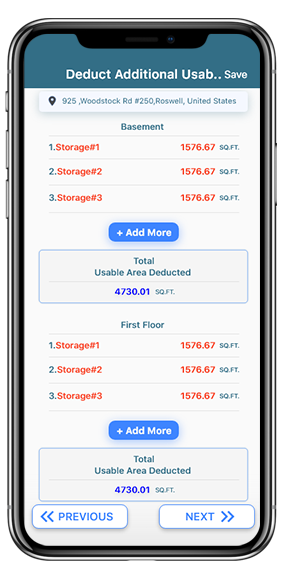Rentable square footage refers to the total area for which a tenant will pay rent in a commercial real estate setting. It encompasses not only the usable square feet of personal office space but also includes a share of common areas like lobbies, restrooms, and hallways. Understanding your rentable square footage as a tenant is vital as it directly affects the rental rate and the amount of space you believe you’re paying for.
Whether you’re a budding entrepreneur seeking a new office space or an established business owner looking to expand, grasping the terms of your rental agreement is key to managing your business overheads. In this article, we’ll explore the essentials of rentable square footage and why it’s an important metric in the world of commercial real estate.
Why Read This Guide? If you’re pondering over lease agreements or simply curious about how commercial property rentals work, this guide is worth your time. Here, we’ll decode complex jargon and offer insights into the best practices for calculating and understanding rentable square footage, empowering you to make informed decisions when it comes to finding the right space for your business.
Key Takeaways:
- Rentable square footage includes both the usable space and a proportionate share of the building’s common areas.
- The load factor plays a crucial role in determining the total rentable square footage for a tenant.
- Knowing how to calculate rentable square footage will provide a clearer understanding of the true cost of a commercial lease.
How to Calculate Rentable Square Footage
There are a few key elements to calculating rentable square footage. The calculation starts with determining the usable square feet – the actual space occupied by a tenant. To this, a proportion based on the load factor, which takes into account shared spaces, is added. Calculating this accurately will ensure tenants aren’t paying more than they should for the space they are leasing.
| Description | Square Footage | Remarks |
| Usable Square Footage | 1,500 sq ft | The actual space occupied by a tenant. |
| Shared Spaces (Load Factor) | 500 sq ft (33% of usable space) | Common areas like hallways, bathrooms, etc. |
| Total Rentable Square Footage | 2,000 sq ft | Sum of usable space and load factor. |
In the table, the usable square footage is given as 1,500 sq ft, and the load factor is represented as an additional 500 sq ft, which is 33% of the usable space. Here’s how the calculation would look:
- Usable Square Footage:
- Given as 1,500 sq ft.
- Load Factor Calculation:
- The load factor is calculated as an additional 33% of the usable space.
- Therefore, Load Factor = ( 1,500 \text{ sq ft} \times 33\% = 495 \text{ sq ft} ).
- For simplicity, we can round this to 500 sq ft.
- Total Rentable Square Footage:
- Total Rentable Square Footage = Usable Square Footage + Load Factor.
- So, Total Rentable Square Footage = ( 1,500 \text{ sq ft} + 500 \text{ sq ft} = 2,000 \text{ sq ft} ).
In this scenario, a tenant who occupies 1,500 square feet of usable space would be responsible for paying for a total of 2,000 square feet, considering the additional space allocated for shared areas like hallways and bathrooms.
The Concept of Usable Square Feet
Usable square feet represents the actual office or workspace that a tenant exclusively occupies. It’s the dimension from wall to wall, not including spaces shared with other tenants or communal areas of the building. This measurement is often what tenants first consider when looking at potential commercial spaces.
Rentable vs Usable Square Feet
The difference between rentable and usable square feet is a common cause of confusion in commercial leases. While usable square footage is the actual space a tenant occupies, rentable square footage includes additional space – specifically, a tenant’s pro-rata share of common areas. Consequently, rentable square footage is often higher than usable square footage.
Understanding the Load Factor
The load factor is a key term in commercial real estate that affects how rentable square footage is calculated. It represents the percentage of common areas relative to the total usable floor area of a building. A higher load factor means greater shared space and, therefore, a larger amount of rentable square feet attributable to each tenant.
Why the Distinction Matters for Tenants
Comprehending the distinction between rentable and usable square footage is vital for tenants, as it influences the perceived value of the space and the rental rate. Tenants should understand this to negotiate lease terms effectively and ensure that they’re not overpaying, especially when comparing two different office spaces with varying load factors.
Impacts on Rental Costs of Commercial Spaces
Rental costs in commercial real estate are largely based on rentable square footage. As such, understanding what constitutes this measurement and how it is calculated will directly impact how much a tenant pays per month for their space.
Navigating Commercial Real Estate Leases
Navigating the nuances of commercial leases can be a daunting task, especially when deciphering the often-complicated language surrounding square footage in lease documents. An understanding of these commercial real estate terminologies is not just helpful but necessary for any business owner who wants to ensure they’re getting the best deal for their needs. With this in mind, let’s delve deeper into some additional important considerations that involve rentable square footage.
Taking a Closer Look at Load Factors and Rental Rates
The load factor can significantly affect the overall rental rate of a commercial property. It is a critical number that determines the amount of rentable square footage, which dictates the price per square foot. Notably, a higher load factor translates to more square feet being billed, even if the actual footprint of exclusive usable space remains the same. Consequently, a tenant must carefully examine the load factor and its implications on the overall rental rate.
The Role of Amenities
Amenities often justify a higher load factor and, accordingly, a more substantial rentable square footage calculation. These might include shared conference rooms, fitness centers, or outdoor spaces that can enhance the experience for tenants and their clientele. While evaluating space, consider whether these amenities add value to your business operations and if they warrant the additional cost implicated by the rentable square footage.
Building’s Total Square Footage vs. Individual Leasable Square Footage
Tenants should also pay attention to the building’s total square footage in relation to their individual leasable square footage. Understanding how your space relates to the building as a whole can provide insight into the proportion of common areas attributed to your lease. It’s essential to verify these proportions to ensure your rentable square footage calculation is accurate and reflective of the actual space and amenities you have access to.
Expert Advice and Lease Negotiations
Given the complexity of commercial leases, seeking expert advice is often a prudent strategy. A real estate broker or a lawyer with expertise in commercial properties can provide valuable assistance in negotiating the terms of a lease. They can help clarify the implications of rentable square footage, validate the accuracy of the load factor, and potentially leverage their knowledge for better lease terms.
Cost of Maintaining Common Areas
Another factor to consider is the cost of maintaining common areas, which can indirectly affect your rent. The maintenance of amenities, lobbies, shared restrooms, and other communal spaces are expenses often reflected in the load factor. This is another reason why understanding how rentable square footage is calculated is vital—it informs you of your fair share of these costs.
U/R Simple: A Revolutionary Tool for Calculating Rentable Square Footage
As we navigate the complexities of commercial leasing, it becomes increasingly important to have accurate tools at our disposal for calculating rentable square footage. This is where the U/R Simple App emerges as a game-changer. This innovative online platform provides a user-friendly and precise way for tenants and landlords alike to determine the rentable square footage of commercial spaces.
Why Choose the U/R Simple App?
- Simplicity and Accuracy: UsableRentable.com simplifies the process of calculating rentable square footage. Its intuitive interface allows users to input their usable square footage and load factor, automatically computing the rentable square footage with precision.
- Time-Saving: The tool saves significant time and effort that would otherwise be spent on manual calculations, making it easier for business owners to focus on other important aspects of their operations.
- Educational Resource: Not only does UsableRentable.com calculate square footage, but it also educates users about the nuances of commercial real estate terms, helping them make more informed decisions.
- Cost-Effective: Understanding the exact rentable square footage helps tenants avoid overpaying for space they aren’t utilizing. This accuracy in calculation can lead to significant cost savings over the duration of a lease.
- Professional Validation: It provides a professional level of validation to the calculations, which can be beneficial during lease negotiations and discussions with landlords.
Integrating U/R Simple App into Your Lease Process
Including UsableRentable.com in your lease process can transform how you approach commercial space rental:
- Before Lease Signing: Use the tool to verify the rentable square footage provided by the landlord or agent.
- During Negotiations: Reference the calculations from UsableRentable.com to negotiate fair lease terms.
- Post-Lease Signing: Use the platform to periodically reassess your space requirements and ensure your lease terms remain beneficial.
UsableRentable.com stands out as an indispensable resource for anyone involved in commercial leasing. Its ease of use, accuracy, and cost-effectiveness make it an ideal solution for calculating rentable square footage, thereby empowering tenants and landlords to foster transparency and fairness in commercial real estate dealings.
Final Takeaways for Tenants
When it comes to commercial real estate leases, tenants should:
- Thoroughly understand the difference between usable and rentable square footage. Clear insights into these terms can make a significant financial difference.
- Calculate rentable square footage meticulously, confirming with building plans or with the help of a professional.
- Negotiate with the knowledge of load factor in hand. Knowing its implications can be a powerful tool during discussions with landlords.
- Recognize the value of the space beyond its cost. Consider whether common space amenities justify the cost of the rentable square footage that aligns with your company’s goals and culture.
To encapsulate, rentable square footage is a cornerstone concept of commercial leasing. Having clarity on how this, and related terms like usable square footage and load factor, influence your lease is a testament to savvy business acumen. It enables tenants to make shrewd, informed decisions that align with their strategic business objectives, ultimately impacting their presence and growth in the chosen commercial space.
Best Practices for Tenants
When considering commercial leases, tenants should thoroughly understand the lease’s specifications regarding space calculations. Confirming the load factor and assessing it against the amenities and services provided is good practice. Tenants should also be proactive in negotiating, possibly seeking expert assistance to ensure they’re getting a fair deal relative to the rentable space.
Continuing to build upon the foundation of knowledge in commercial real estate, it’s beneficial to familiarize oneself with industry standards, like those set by the Building Owners and Managers Association (BOMA), which can help elucidate the often-complex calculations and terms utilized in determining space measurements and successfully setting rental rates.
Furthermore, while attention to numerical details is critical, tenants must also weigh the quality of the space itself. Factors such as the location, accessibility, and the potential for growth should be carefully considered alongside the cost. After all, the workspace is where the business comes to life, and a harmonious balance between cost, comfort, and potential for profitability should be the ultimate goal.
In summary, rentable square footage is a pivotal concept in commercial leasing, occupying center stage when it comes to understanding the financial aspects of renting a commercial property. Mastery of this concept will enable tenants to strategically select their business’s home, negotiate with confidence, and align their operational goals with their fiscal realities.




